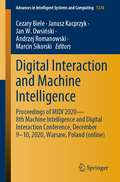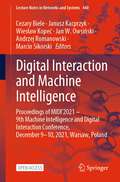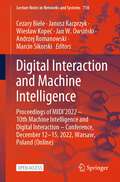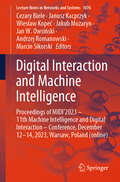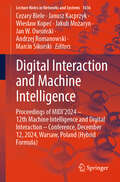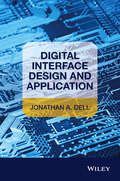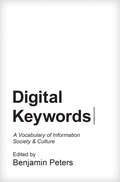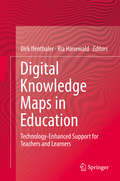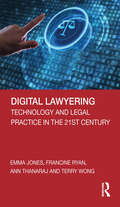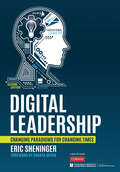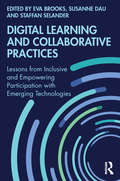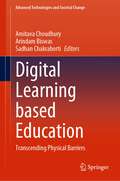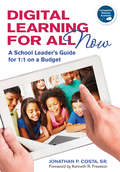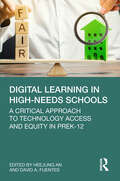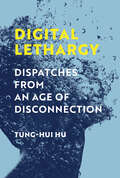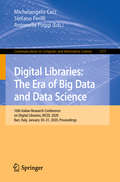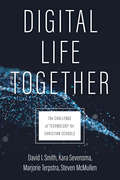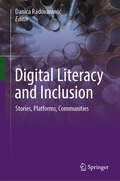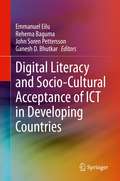- Table View
- List View
Digital Interaction and Machine Intelligence: Proceedings of MIDI’2020 – 8th Machine Intelligence and Digital Interaction Conference, December 9-10, 2020, Warsaw, Poland (online) (Advances in Intelligent Systems and Computing #1376)
by Janusz Kacprzyk Jan W. Owsiński Cezary Biele Andrzej Romanowski Marcin SikorskiThis book presents the Proceedings of MIDI’2020 – 8th Machine Intelligence and Digital Interaction Conference, December 9–10, 2020, Warsaw, Poland, held online. The rapid development of artificial intelligence (AI) and its growing applications in many fields, such as intelligent voice assistants, e-commerce (chatbots) or navigation, make end users increasingly exposed to such systems. In a world where technological solutions based on artificial intelligence are created by people for people, the final success or failure of a newly created product depends on the focus on human needs. Therefore, it is important to integrate so far independent scientific areas: broadly defined artificial intelligence and human–technology interaction. This book is intended for specialists in the above fields and attempts to integrate the perspectives of engineers and social scientists. The book is a source of inspiration as well as practical and theoretical knowledge for all readers interested in new trends in the field of user-centered AI solutions.
Digital Interaction and Machine Intelligence: Proceedings of MIDI’2021 – 9th Machine Intelligence and Digital Interaction Conference, December 9-10, 2021, Warsaw, Poland (Lecture Notes in Networks and Systems #440)
by Janusz Kacprzyk Jan W. Owsiński Cezary Biele Andrzej Romanowski Marcin Sikorski Wiesław KopećThis book is open access, which means that you have free and unlimited access.This book presents the Proceedings of the 9th Machine Intelligence and Digital Interaction Conference. Significant progress in the development of artificial intelligence (AI) and its wider use in many interactive products are quickly transforming further areas of our life, which results in the emergence of various new social phenomena. Many countries have been making efforts to understand these phenomena and find answers on how to put the development of artificial intelligence on the right track to support the common good of people and societies. These attempts require interdisciplinary actions, covering not only science disciplines involved in the development of artificial intelligence and human-computer interaction but also close cooperation between researchers and practitioners. For this reason, the main goal of the MIDI conference held on 9-10.12.2021 as a virtual event is to integrate two, until recently, independent fields of research in computer science: broadly understood artificial intelligence and human-technology interaction.
Digital Interaction and Machine Intelligence: Proceedings of MIDI’2022 – 10th Machine Intelligence and Digital Interaction – Conference, December 12-15, 2022, Warsaw, Poland (Online) (Lecture Notes in Networks and Systems #710)
by Janusz Kacprzyk Jan W. Owsiński Cezary Biele Andrzej Romanowski Marcin Sikorski Wiesław KopećThis open access book presents the proceedings of the 10th Machine Intelligence and Digital Interaction Conference. Artificial intelligence (AI) is rapidly affecting more aspects of our lives as a result of significant advancements in its research and the widespread usage of interactive technologies. This has led to the birth of several new social phenomena. Many nations have been working to comprehend these phenomena and discover solutions for moving artificial intelligence development in the proper direction to benefit individuals and communities at large. These efforts necessitate multidisciplinary approaches, encompassing not only the scientific fields involved in the creation of artificial intelligence and human–computer interaction but also strong collaboration between academics and practitioners. Because of this, the primary objective of the MIDI conference, which was conducted online on December 13–15, 2022, is to combine two up until recently distinct disciplines of research—artificial intelligence and human–technology interaction.
Digital Interaction and Machine Intelligence: Proceedings of MIDI’2023 – 11th Machine Intelligence and Digital Interaction – Conference, December 12-14, 2023, Warsaw, Poland (online) (Lecture Notes in Networks and Systems #1076)
by Janusz Kacprzyk Jan W. Owsiński Cezary Biele Andrzej Romanowski Marcin Sikorski Wiesław Kopeć Jakub MożarynArtificial intelligence (AI) is revolutionizing our daily lives, thanks to remarkable advancements in research and the widespread adoption of interactive technologies. This transformation has ushered in a wave of new social phenomena, prompting nations worldwide to seek understanding and solutions. These efforts necessitate multidisciplinary approaches, encompassing not only the scientific fields involved in the creation of artificial intelligence and human–computer interaction but also strong collaboration between academics and practitioners, discovering more in the MIDI conference proceedings book, and featuring the latest insights from the conference held online on December 12–14, 2023 that combine two up until recently distinct disciplines of research—artificial intelligence and human–technology interaction.
Digital Interaction and Machine Intelligence: Proceedings of MIDI’2024 – 12th Machine Intelligence and Digital Interaction – Conference, December 12, 2024, Warsaw, Poland (Hybrid Formula) (Lecture Notes in Networks and Systems #1636)
by Janusz Kacprzyk Jan W. Owsiński Cezary Biele Andrzej Romanowski Marcin Sikorski Wiesław Kopeć Jakub MożarynThis book presents the Proceedings of the 12th Machine Intelligence and Digital Interaction Conference, and it combines two disciplines of research. The rapid progress in artificial intelligence research and the widespread use of interactive technologies are fundamentally changing our daily lives. This has given rise to new social dynamics, compelling nations around the world to develop new insights and strategies. Addressing these changes effectively demands a multidisciplinary strategy, uniting experts from AI and human-computer interaction with both academic researchers and industry practitioners. The proceedings from the 2024 MIDI conference offer the latest research on the convergence of these two formerly separate fields.
Digital Interface Design and Application
by Jonathan A. DellJonathan A. Dell University of York, UK Many computer applications require microprocessors to reliably interconnect and communicate with other peripherals in order to perform their intended functions. Interface design, which includes the development of the methods and processes by which two or more components communicate, is a crucial step in the deployment of microprocessors in an embedded computing environment. ARM-based microprocessors are a leading technology in this field, offering a wide range of performance for different applications. This book provides a comprehensive treatment of interface design from basic logical and theoretical principles to practical implementation on an ARM-based microprocessor, addressing both hardware and software considerations. The microprocessor's high level of complexity is carefully analysed in the text to provide clear guidance for the reader in the design of new applications, resulting in an invaluable reference resource for graduates and engineers involved in the design of electronic products and systems.Key Features: Brings together aspects of digital hardware, interface design and software integration in a single text to make clear the link between low and high level languages for interface control Categorises interface techniques into easily distinguished chapters, progressively involving greater complexity, enabling the reader to quickly find relevant material for a particular application Provides many practical C-coded examples showing both the preparation and use of complex programmable subsystems implemented in a typical commercial product Presents in each chapter an introduction to the essential theoretical aspects and the development of simple interface designs using basic logical building blocks
Digital Keywords: A Vocabulary of Information Society and Culture
by Benjamin PetersIn the age of search, keywords increasingly organize research, teaching, and even thought itself. Inspired by Raymond Williams's 1976 classic Keywords, the timely collection Digital Keywords gathers pointed, provocative short essays on more than two dozen keywords by leading and rising digital media scholars from the areas of anthropology, digital humanities, history, political science, philosophy, religious studies, rhetoric, science and technology studies, and sociology. Digital Keywords examines and critiques the rich lexicon animating the emerging field of digital studies. This collection broadens our understanding of how we talk about the modern world, particularly of the vocabulary at work in information technologies. Contributors scrutinize each keyword independently: for example, the recent pairing of digital and analog is separated, while classic terms such as community, culture, event, memory, and democracy are treated in light of their historical and intellectual importance. Metaphors of the cloud in cloud computing and the mirror in data mirroring combine with recent and radical uses of terms such as information, sharing, gaming, algorithm, and internet to reveal previously hidden insights into contemporary life. Bookended by a critical introduction and a list of over two hundred other digital keywords, these essays provide concise, compelling arguments about our current mediated condition. Digital Keywords delves into what language does in today's information revolution and why it matters.
Digital Knowledge Maps in Education
by Dirk Ifenthaler Ria HanewaldDigital knowledge maps are 'at a glance' visual representations that enable enriching, imaginative and transformative ways for teaching and learning, with the potential to enhance positive educational outcomes. The use of such maps has generated much attention and interest among tertiary education practitioners and researchers over the last few years as higher education institutions around the world begin to invest heavily into new technologies designed to provide online spaces within which to build resources and conduct activities. The key elements of this edited volume will comprise original and innovative contributions to existing scholarship in this field, with examples of pedagogical possibilities as they are currently practiced across a range of contexts. It will contain chapters that address, theory, research and practical issues related to the use of digital knowledge maps in all aspects of tertiary education and draws predominantly on international perspectives with a diverse group of invited contributors. Reports on empirical studies as well as theoretical/conceptual chapters that engage deeply with pertinent questions and issues raised from a pedagogical, social, cultural, philosophical, and/or ethical standpoint are included. Systematic literature reviews dealing with digital knowledge mapping in education are also an integral part of the volume.
Digital Lawyering: Technology and Legal Practice in the 21st Century
by Emma Jones Francine Ryan Ann Thanaraj Terry WongIn today’s rapidly changing legal landscape, becoming a digital lawyer is vital to success within the legal profession. This textbook provides an accessible and thorough introduction to digital lawyering, present and future, and a toolkit for gaining the key attributes and skills required to utilise technology within legal practice effectively. Digital technologies have already begun a radical transformation of the legal profession and the justice system. Digital Lawyering introduces students to all key topics, from the role of blockchain to the use of digital evidence in courtrooms, supported by contemporary case studies and integrated, interactive activities. The book considers specific forms of technology, such as Big Data, analytics and artificial intelligence, but also broader issues including regulation, privacy and ethics. It encourages students to explore the impact of digital lawyering upon professional identity, and to consider the emerging skills and competencies employers now require. Using this textbook will allow students to identify, discuss and reflect on emerging issues and trends within digital lawyering in a critical and informed manner, drawing on both its theoretical basis and accounts of its use in legal practice. Digital Lawyering is ideal for use as a main textbook on modules focused on technology and law, and as a supplementary textbook on modules covering lawyering and legal skills more generally.
Digital Leadership: Changing Paradigms for Changing Times
by Eric C. SheningerLead for efficacy in these disruptive times! Just as the digital landscape is constantly evolving, the second edition of Digital Leadership moves past trends and fads to focus on the essence of leading innovative change in education now and in the future. As society and technology evolve at what seems a dizzying pace, the demands on leaders are changing as well. With a greater emphasis on leadership dispositions, this revamped edition also features New structure and organization emphasizing the interconnectivity of the Pillars of Digital Leadership to drive sustainable change Innovative strategies and leadership practices that enhance school culture and drive learning improvement Updated vignettes from digital leaders who have successfully implemented the included strategies New online resources, informative graphics, and end of chapter guiding questions Now is the time to embrace innovation, technology, and flexibility to create a learning culture that provides students with 21st century critical competencies!
Digital Leadership: Changing Paradigms for Changing Times
by Eric C. SheningerLead for efficacy in these disruptive times! Just as the digital landscape is constantly evolving, the second edition of Digital Leadership moves past trends and fads to focus on the essence of leading innovative change in education now and in the future. As society and technology evolve at what seems a dizzying pace, the demands on leaders are changing as well. With a greater emphasis on leadership dispositions, this revamped edition also features New structure and organization emphasizing the interconnectivity of the Pillars of Digital Leadership to drive sustainable change Innovative strategies and leadership practices that enhance school culture and drive learning improvement Updated vignettes from digital leaders who have successfully implemented the included strategies New online resources, informative graphics, and end of chapter guiding questions Now is the time to embrace innovation, technology, and flexibility to create a learning culture that provides students with 21st century critical competencies!
Digital Learning and Collaborative Practices: Lessons from Inclusive and Empowering Participation with Emerging Technologies
by Eva Brooks Staffan Selander Susanne DauDigital Learning and Collaborative Practices offers a comprehensive overview of design-based, technology-enhanced approaches to teaching and learning in virtual settings. Today’s digital communications foster new opportunities for sharing culture and knowledge while also prompting concerns over division, disinformation and surveillance. This book uniquely emphasises playful, collaborative experiences and democratic values in a variety of environments—adaptive, augmented, dialogic, game-based and beyond. Graduate students and researchers of educational technology, the learning sciences and interaction design will discover rich theories, interventions, models and approaches for concretising emerging practices and competencies in digital learning spaces.
Digital Learning based Education: Transcending Physical Barriers (Advanced Technologies and Societal Change)
by Arindam Biswas Amitava Choudhury Sadhan ChakrabortiThis book presents the systematic evolution of digitized education: trends, advances, challenges encountered and their solutions toward the use of advanced technologies. The book mainly covers variety of areas such as blended learning in modern education, flipped classroom, ICT-based education, digital transformation of education. Explosion of information and communication technologies has transformed the way we live, learn, work and socialize. This heavy intervention of technologies in the modern world has triggered us to think how we engage and interact with each other and how we make use of these digital tools and communications channels. And consequent upon which societies are transforming into digitized education where datafication, platformization and algorithmic governance are a common vocabulary.
Digital Learning for All, Now: A School Leader's Guide for 1:1 on a Budget
by Jonathan P. CostaDesigning the practically paperless classroom Imagine students carrying mobile devices instead of a backpack. This breakthrough guide shows educators how to affordably transform schools into digital learning centers. Jonathan P. Costa, Sr. outlines a step-by-step road map of solutions for overcoming budget and systems barriers and moving forward with a sense of urgency. His field-tested strategies show how to: Acquire and pay for necessary equipment; Save money by utilizing open source, crowd sourcing, and Bring Your Own Device; Align instruction, assessment, curriculum, and professional development for a 21st century learning environment. A content-rich companion website provides adaptable tools, step-by-step guidance, resources, and access to an online interactive community.
Digital Learning in High-Needs Schools: A Critical Approach to Technology Access and Equity in PreK-12
by Heejung An David A. FuentesDigital Learning in High-Needs Schools examines the challenges and affordances that arise when high-needs school communities integrate educational technologies into their unique settings. Although remote, blended, and networked learning are ubiquitous today, a number of cultural, economic, and political realities—from the digital divide and digital literacy to poverty and language barriers—affect our most vulnerable and underresourced teachers and students. This book uses critical theory to compassionately scrutinize and unpack the systemic issues that impact high-needs schools’ implementation of digital learning tools. Incisive sociocultural analyses across fifteen original chapters explore the intersection of society, technology, people, politics, and education in high-needs school contexts. Informed by real-world cases pertaining to technology infrastructure, formative feedback, Universal Design for Learning, and more, these chapters illuminate how best practices emerge from culturally responsive and context-specific foundations.
Digital Learning in High-Needs Schools: A Critical Approach to Technology Access and Equity in PreK-12
by Heejung An David A. FuentesDigital Learning in High-Needs Schools examines the challenges and affordances that arise when high-needs school communities integrate educational technologies into their unique settings. Although remote, blended, and networked learning are ubiquitous today, a number of cultural, economic, and political realities—from the digital divide and digital literacy to poverty and language barriers—affect our most vulnerable and underresourced teachers and students. This book uses critical theory to compassionately scrutinize and unpack the systemic issues that impact high-needs schools’ implementation of digital learning tools. Incisive sociocultural analyses across fifteen original chapters explore the intersection of society, technology, people, politics, and education in high-needs school contexts. Informed by real-world cases pertaining to technology infrastructure, formative feedback, Universal Design for Learning, and more, these chapters illuminate how best practices emerge from culturally responsive and context-specific foundations.
Digital Legend and Belief: The Slender Man, Folklore, and the Media
by Andrew PeckThe internet brings new urgency to the study of folklore. The digital networks we use daily amplify legends' capacity to spread swiftly, define threats, and inform action. Using the case of a particularly popular digital bogeyman known as the Slender Man, Andrew Peck brings the study of legends into the twenty-first century. Peck explains not only how legends circulate in the digital swirl of the internet but also how the internet affects how legends seep into our offline lives and into the mass media we consume. What happens, he asks, when legends go online? How does the internet enable the creation of new legends? How do these ideas go viral? How do tradition and technology interact to construct collaborative beliefs? Peck argues that the story of the Slender Man is really a story about the changing nature of belief in the age of the internet. Widely adopted digital technologies, from smartphones to social media, offer vast potential for extending traditional and expressive social behaviors in new ways. As such, understanding the online landscape of contemporary folklore is crucial for grasping the formation and circulation of belief in the digital age. Ultimately, Peck argues that advancing our comprehension of legends online can help us better understand how similar belief genres like fake news, conspiracy theories, hoaxes, rumors, meme culture, and anti-expert movements are enabled by digital media.
Digital Lethargy: Dispatches from an Age of Disconnection
by Tung-Hui HuThe exhaustion, disappointment, and listlessness experienced under digital capitalism, explored through works by contemporary artists, writers, and performers.Sometimes, interacting with digital platforms, we want to be passive—in those moments of dissociation when we scroll mindlessly rather than connecting with anyone, for example, or when our only response is a shrugging &“lol.&” Despite encouragement by these platforms to &“be yourself,&” we want to be anyone but ourselves. Tung-Hui Hu calls this state of exhaustion, disappointment, and listlessness digital lethargy. This condition permeates our lives under digital capitalism, whether we are &“users,&” who are what they click, or racialized workers in Asia and the Global South. Far from being a state of apathy, however, lethargy may hold the potential for social change. Hu explores digital lethargy through a series of works by contemporary artists, writers, and performers. These dispatches from the bleeding edge of digital culture include a fictional dystopia where low-wage Mexican workers laugh and emote for white audiences; a group that invites lazy viewers to strap their Fitbits to a swinging metronome, faking fitness and earning a discount on their health insurance premiums; and a memoir of burnout in an Amazon warehouse. These works dwell within the ordinariness and even banality of digital life, redirecting our attention toward moments of thwarted agency, waiting and passing time. Lethargy, writes Hu, is a drag: it weighs down our ability to rush to solutions, and forces us to talk about the unresolved present.
Digital Libraries: 16th Italian Research Conference on Digital Libraries, IRCDL 2020, Bari, Italy, January 30–31, 2020, Proceedings (Communications in Computer and Information Science #1177)
by Stefano Ferilli Michelangelo Ceci Antonella PoggiThis book constitutes the thoroughly refereed proceedings of the 16th Italian Research Conference on Digital Libraries, IRCDL 2020, held in Bari, Italy, in January 2020.The 12 full papers and 6 short papers presented were carefully selected from 26 submissions. The papers are organized in topical sections on information retrieval, bid data and data science in DL; cultural heritage; open science.
Digital Life Together: The Challenge of Technology for Christian Schools
by David I. Smith Steven McMullen Kara Sevensma Marjorie TerpstraDigital technologies loom large in the experience of today&’s students. However, parents, teachers, and school leaders have only started to take stock of the ramifications for teaching, learning, and faith. Based on a three-year in-depth study of Christian schools, Digital Life Together walks educators, school leaders, and parents through some of the big ideas that are hidden in our technology habits, going beyond general arguments for or against digital devices to address the nuanced realities of Christian education in a twenty-first-century context.
Digital Life Together: The Challenge of Technology for Christian Schools
by David I. Smith Steven McMullen Kara Sevensma Marjorie TerpstraDigital technologies loom large in the experience of today&’s students. However, parents, teachers, and school leaders have only started to take stock of the ramifications for teaching, learning, and faith. Based on a three-year in-depth study of Christian schools, Digital Life Together walks educators, school leaders, and parents through some of the big ideas that are hidden in our technology habits, going beyond general arguments for or against digital devices to address the nuanced realities of Christian education in a twenty-first-century context.
Digital Lifeline?: ICTs for Refugees and Displaced Persons (Information Policy)
by Carleen F. MaitlandInterdisciplinary perspectives on the role of new information technologies, including mobile phones, wireless networks, and biometric identification, in the global refugee crisis.Today's global refugee crisis has mobilized humanitarian efforts to help those fleeing persecution and armed conflict at all stages of their journey. Aid organizations are increasingly employing new information technologies in their mission, taking advantage of proliferating mobile phones, remote sensors, wireless networks, and biometric identification systems. Digital Lifeline? examines the use of these technological innovations by the humanitarian community, exploring operations and systems that range from forecasting refugee flows to providing cellular and Internet connectivity to displaced persons. The contributors, from disciplines as diverse as international law and computer science, offer a variety of perspectives on forced migration, technical development, and user behavior, drawing on field work in countries including Jordan, Lebanon, Rwanda, Germany, Greece, the United States, and Canada. The chapters consider such topics as the use of information technology in refugee status determination; ethical and legal issues surrounding biometric technologies; information technology within organizational hierarchies; the use of technology by refugees; access issues in refugee camps; the scalability and sustainability of information technology innovations in humanitarian work; geographic information systems and spatial thinking; and the use of “big data” analytic techniques. Finally, the book identifies policy research directions, develops a unified research agenda, and offers practical suggestions for conducting displacement research.ContributorsElizabeth Belding, Karen E. Fisher, Daniel Iland, Lindsey N. Kingston, Carleen F. Maitland, Susan F. Martin, Galya Ben-Arieh Ruffer, Paul Schmitt, Lisa Singh, Brian Tomaszewski, Mariya Zheleva
Digital Literacies: Social Learning and Classroom Practices (Published in association with the UKLA)
by Victoria Carrington Muriel RobinsonFacebook, blogs, texts, computer games, instant messages… The ways in which we make meanings and engage with each other are changing. Are you a student teacher trying to get to grips with these new digital technologies? Would you like to find ways to make use of them in your classroom? Digital technologies are an everyday part of life for students and Understanding Digital Literacies explores the ways in which they can be used in schools. Carrington and Robinson provide an insight into the research on digital technologies, stressing its relevance for schools, and suggest ways to develop new, more relevant pedagogies, particularly for social learning, literacy and literate practices. With a practical focus, the examples and issues explored in this book will help you to analyse your own practice and to carry out your own small-scale research projects. Explaining the theoretical issues and demonstrating their practical implementation, this topical book will be an essential resource to new student teachers on undergraduate and PGCE courses, and those returning to postgraduate study.
Digital Literacy and Inclusion: Stories, Platforms, Communities
by Danica RadovanovićAmid the opportunities and challenges we face at the dawn of the fifth industrial revolution, Digital Literacy and Inclusion presents a carefully curated selection of case studies, theories, research, and best practices based on digital literacy as a prerequisite for effective digital inclusion.More than a dozen experts provide deep insights in stories, research reports, and geographical studies of digital literacy and inclusion models, all from a multi-disciplinary perspective that includes engineering, social sciences, and education. Digital Literacy and Inclusion also highlights a showcase of real-world digital literacy initiatives that have been adopted by communities of practice around the globe.Contributors explore myriad aspects and modalities of digital literacy: digital skills related to creativity, urban data literacy, digital citizenship skills, digital literacy in education, connectivity literacy, online safety skills, problem-solving and critical-thinking digital skills, data literacy skills, mobile digital literacy, algorithmic digital skills, digital health skills, etc. They share the principles and techniques behind successful initiatives and examine the dynamics and structures that enable communities to achieve digital literacy efficiently and sustainably. Their practical solutions, propositions, and findings provide theoretically grounded and evidence-based facts that inform interventions intended to ensure that all citizens have and can enhance their digital literacy while meaningfully and responsibly participating in the digital economy and society.The ideas and histories in this book will appeal to scholars and researchers in the social sciences, engineering, education, sustainable digital technologies, and transformation, and will also be of interest to practitioners in industry, policy, and government.
Digital Literacy and Socio-Cultural Acceptance of ICT in Developing Countries
by Emmanuel Eilu Rehema Baguma John Soren Pettersson Ganesh D. BhutkarThis book discusses the role of human computer interaction (HCI) design in fostering digital literacy and promoting socio-cultural acceptance and usage of the latest ICT innovations in developing countries. The book presents techniques, theories, case studies, and methodologies in HCI design approaches that have been used to foster digital literacy, break the socio-cultural barriers to ICT adoption, and promote the widespread usage of the latest innovations in the health, agriculture, economic, education and social sectors in developing countries. The authors provide insights on how crossing disciplines in HCI such as usability design, user centered design, user experience, anticipated user experience, technology acceptance design, persuasive design, philosophical designs, motivational design, social-cultural oriented designs, and other HCI design approaches have promoted digital literacy and stimulated socio-cultural acceptance and the usage of the latest ICT innovations. The book is relevant in academic, industry and government.Presents theoretical, practical, and socio-cultural approaches to digital literacy challenges in developing countries;Discusses recent ICT and HCI innovations used to transform the health, agriculture, economic, education and social sectors in developing countries;Provides insights on design opportunities and challenges presented in countries where digital literacy is very low and with complex socio-cultural dynamics.
